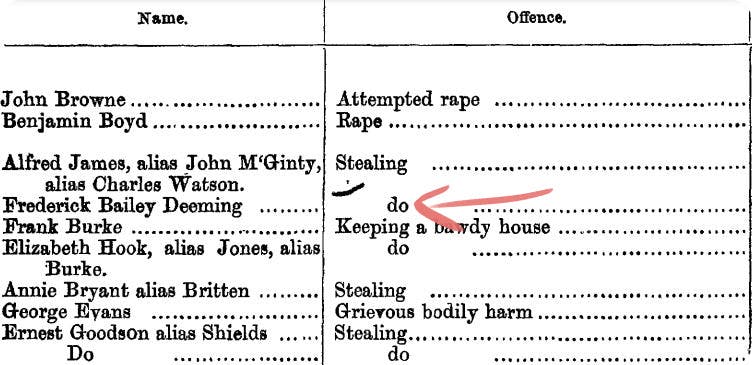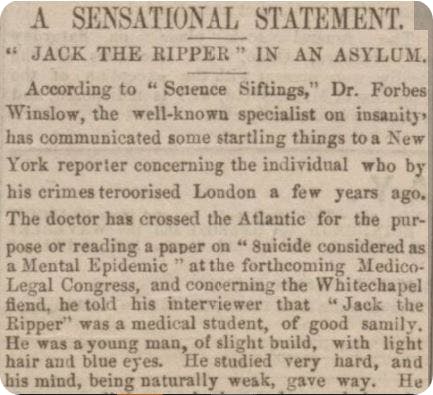Who was Jack the Ripper? The answer may be hidden in our family records
4-5 minute read
By Niall Cullen | August 30, 2021

Jack the Ripper's identity has been shrouded in mystery for over a century. We've dug deeper into his notorious crimes, getting to know the victims and suspects a little better with the help of our family records and newspapers.
Jack the Ripper is arguably the most famous serial killer in British history. The murderer terrorised Whitechapel, London in the late 19th century, actively targeting female prostitutes. Despite his high profile, Jack the Ripper's identity still perplexes and fascinates history buffs today. Can Findmypast's family records and newspapers from the time shed new light on Jack the Ripper's unsolved crimes?
Discover murder and mayhem in crime records
Enter a few details to unlock grisly details from the past
We're reopening this iconic case, investigating Jack the Ripper's victims, the suspects in the frame and why this elusive killer was never caught.
How many people did Jack the Ripper kill?
It's believed that Jack the Ripper murdered at least five women, all prostitutes in the east end of London:
- Mary Ann Nichols
- Annie Chapman
- Elizabeth Stride
- Catherine Eddowes
- Mary Jane Kelly
They were murdered between August and November 1888 and became known as the canonical five. Jack the Ripper's first victim was Mary Ann 'Polly' Nichols while Mary Jane Kelly was his last.
However, the famous Whitechapel murders went beyond these five victims. Between April 1888 and February 1891 there were eleven unsolved killings in the area. Was Jack the Ripper responsible for all of them? Several other murders from the time have also been linked, inconclusively, to Jack the Ripper.
To get to know the people behind Jack the Ripper's victims' names, we looked at the 1881 UK Census, taken just seven years before they met their demise.
Folklore has portrayed the victims as young, lifelong prostitutes, struck down in the prime of their lives. But the census records tell a different story. By the time of their deaths, they were mostly in their 40s and had previously been living, at least on paper, respectable family lives.
Catherine Eddowes
Catherine Eddowes appears on the 1881 Census as ‘Kate Conway’ and is listed as a 'charwoman'.

Catherine Eddowes in the 1881 UK Census. View the full record.
She was living in Chelsea with her common-law husband, Thomas Conway (a ‘hawker’), plus their two children.
Elizabeth Stride
Elizabeth Stride, who is believed to be Jack the Ripper's third victim, had worked as a prostitute in her 20s.

Elizabeth Stride in the 1881 UK Census. View the full record.
But by 1881 (then aged 37), it seems she had escaped that life and was living in Bow with her husband John Stride, a carpenter.
Annie Chapman
Annie Chapman was staying with her parents on the night of the 1881 Census with her three children. Her husband, John Chapman, was living above stables in Berkshire, where Annie and the children later joined him.

Annie Chapman in the 1881 UK Census. View the full record.
Annie and John Chapman's eldest child, Emily Ruth, died in 1882 of meningitis, aged just 12. In the wake of this tragedy, both parents drank heavily, which probably led to their separation and Annie Chapman’s descent into prostitution.
We couldn't find Mary Ann Nichols or Mary Jane Kelly (the only victim in her 20s) in the 1881 Census. They may have been walking the streets on the night it was taken. Ten years earlier in the 1871 UK Census, Nichols was listed as married with three children.
Do these revelations add a different perspective to the legendary story of Jack The Ripper and give us a better insight into the killer's motivations? Perhaps he was targeting vulnerable middle-aged women, rather than young prostitutes? Maybe this changes the profile of the man that sleuths have been trying to identify for over a century.
Who were the Jack the Ripper suspects?
The Jack the Ripper suspect list includes artists, authors and even a member of the British royal family.
Since the initial police investigation, more theories about the serial killer's identity have been put forward. Was Jack the Ripper a doctor? Was Jack the Ripper a woman? Was Jack the Ripper even a real person?
There are over 100 names on the suspect list. We've used our family records to examine some of them in more detail.
Frederick Deeming
Frederick Bailey Deeming was a serial bigamist, fraudster and murderer who was widely claimed by the Victorian press to be the real Jack the Ripper.

Yorkshire Gazette, 26 March 1892. View the full article.
Born in Leicestershire in 1853, Deeming began his criminal activities in Melbourne, Australia and in 1887 was jailed under a charge of bankruptcy.

Frederick Deeming listed in New South Wales Police Gazette, 1882. View the full record.
His life of crime continued with bigamy and several brutal murders on his list of offences. Deeming is said to have confessed to his fellow prison inmates that he was Jack the Ripper however it's thought he was in South Africa at the time of the murders. He was hanged in Melbourne in 1892. The hallmarks of his crimes certainly match those of Jack the Ripper but does the circumstantial evidence rule Frederick Deeming out?
Francis Tumblety
Dr Francis Tumblety was a misogynistic American medical quack who lived in London during the Whitechapel murders. According to the 1900 US Census, he was born in Baltimore, Maryland to Irish Immigrant parents.

Francis Tumblety in the 1900 US Census. View the full record.
After being connected to a series of crimes in America, including the assassination of Abraham Lincoln, he fled to London. Many believe that Tumblety is the most likely candidate for the true identity of Jack the Ripper. He was outspoken in his hatred of women and his gruesome cabinet of anatomical specimens has never been explained.
Forbes Winslow
Originally involved in the hunt for Jack the Ripper, Lyttelton Stewart Forbes Winslow has since emerged as a suspect himself. A qualified physician with a tarnished reputation, he grew up in his father's asylum. Winslow's unorthodox background places him, perhaps unfairly, in the frame.

Forbes Winslow featured in a 1913 medical register. View the full record.
According to newspaper reports from the time, in October 1895 Winslow claimed to have received a blood-stained note reading;
"“Next week you will hear of me – Jack the Ripper.""
Winslow pinned his accusations on Canadian religious maniac G. Wentworth Smith but was he trying to deflect suspicion away from himself?

Western Times, 1 October 1895. View the full record.
Other notable names on the Jack the Ripper suspect list include Prince Albert Victor, Duke of Clarence and Avondale, author Lewis Carroll and Sir John Williams.
Whoever he was, Jack The Ripper's killing spree continues to fascinate true crime and history fans around the world. His identity has baffled generations of would-be Sherlocks. Do our family records and newspaper reports from the time bring a new perspective to the famous case? Have a rummage in our resources today to see if you can unearth new evidence. Who knows where the past will take you.
Related articles recommended for you

The history of the Barrow-in-Furness Shipyard
History Hub

We found war veterans and healthcare workers within Keir Starmer's family tree
Discoveries

Who's who on King Charles III's family tree?
Build Your Family Tree

